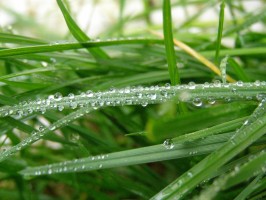Latest Posts
- Have a purpose when backyardingAugust 5 2021
- Study: Time outside alters our microbiomeAugust 4 2021
- Happy National Mutt Day from Mo-MoJuly 27 2021
- New home? Avoid these common mistakes in your yard.July 26 2021
- Infographic: Plan a backyard staycation this summerJuly 22 2021
Categories
Archive
April 22nd
Why your lawn is a sponge for rain water

Many areas of the country have been experiencing a wet spring so far. Did you know that living landscapes help capture and cleanse the storm water? Without grass, more pollutants will enter streams, aquifers and other water sources due to water runoff.
You see, with hard surfaces – like hardscapes, parking lots, driveways and roads – water “sheets off” and quickly turns into storm water runoff. This is one of the major causes of poor water quality.
But grassy areas mitigate storm water runoff. They slow down and absorb the water, while also cleansing it of impurities and dust. Your yard acts like a sponge, trapping water and increasing groundwater recharge.
Interestingly, the biology of turfgrass makes your lawn a nearly ideal medium for the biodegradation of all sorts of environmental contamination.[i] Research has shown that turfgrass is excellent at filtering excess nutrients and sediment.[ii] The grass filtration system is so effective that rain water filtered through a healthy lawn is often as much as 10 times less acidic than water running off a hard surface.[iii] Once it’s absorbed, microbes in the soil help break down chemicals into harmless materials.[iv]
These are just some of the enviro-facts that TurfMutt and the Outdoor Powers want to share. For more scientific stats and info about the benefits of living landscapes, click here.
________________





